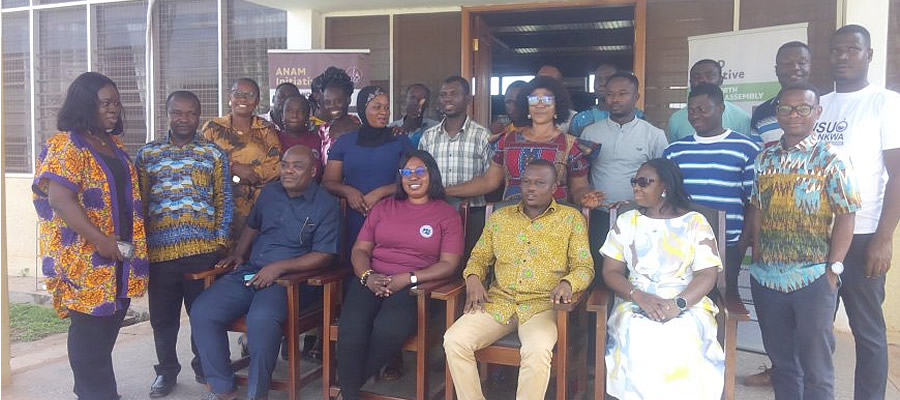

District Annual Action Plan
The District’s Annual Action Plan forms one of the core issues of the Medium Term Development Policy Framework under Ghana Shared Growth and Development Agenda. Basically, it deals with the implementation of various projects and programmes including roles, procedures that would translate them into real actions to achieve the set objectives.
The District development goal for 2014-2017 Ghana Shared Growth and Development Agenda for the Asutifi North District is to make sure that the people in the District have access to quality education, better health delivery system, good drinking water, proper security, and ultimately take part in the decision- making process of the Assembly.
In preparing the Annual Action Plan the following areas are to be taken into consideration
• Action to be taken
• Location of the action
• Who to take that action
• The time frame of the action
• Agency responsible for the action
• Who the Assembly would collaborate with and
• A budget indicating the cost of all plan programmes and projects.
To help make the implementation of 2014-2017 Medium Term Development Policy Framework a reality, there is the need to strengthen and resource all the sector departments in the District. The various Area Councils and Unit Committees within the umbrella of the District Assembly should also be strengthened in a bid to assist in the development planning process within their domain to deepen the decentralisation process.
The District Planning Co-ordinating Unit which is responsible for monitoring, evaluation and co-ordinating all activities of the Assembly should also be resourced to ensure effective implementation of these lofty programmes and activities. All these measures are therefore needed to ensure smooth running, high productivity, and for that matter improve administrative capabilities of all sector departments and other institutions of the Assembly. In addition to the development planning process of the Assembly, there is the need to facilitate all the integrative aspects in development, ensure institutional harmony that builds upon local community involvement and initiative for the total development of the District.
Development Prospects
Development Prospects for Plan Period
In line with the NDPC guidelines and projections made in the GPRS II the aspirations of the communities and the private sector in the district, the following development prospects have been agreed on for the next four – years.
- Improved Infrastructural Development
- Modernized Agriculture based on Rural Development
- Enhanced Social Services with emphasis on Education and Health
- Increased citizenry participation for Good governance
- Public – Private sector partnership to enhance Private Sector Competitiveness
- Responsible Mining
The development prospects for the Asutifi District include projections of the district population, human resource development, skills and entrepreneurial development, private sector competitiveness and good governance which include facilitating responsible mining in the district.
Projections
Projections deals with future trends in various attributes and guides the achievement of accelerated socio economic development. The projections for the medium term were limited to population, school attendance, employment and agricultural production.
The population of settlements above was projected using the average growth rate of the individual settlements observed during the censual periods 1960, 1984 and 2000. Kenyasi No. 2, Hwediem and Acherensua are the only communities with urban status based on the 2000 population census standards. However net migration factor has come into play in determining urban status in communities like Kenyasi No. 1 and Ntotroso where lots of people have migrated to work at the mines or seek job.
A critical look at the settlement pattern and growth coupled with the current trends of migration in the minetake areas, one is tempted to conclude that future grow in the district will be tilted towards the mining communities.
The projection gives an indication of settlements which could be developed into growth centres to serve as a measure to know the range and level of services needed to match the growing population of the settlements.
Labour force projections
The population in the potential labour force (15-64) constitutes 54.7% percent of the projected population. Again, this constitutes a huge increase and a resource to the district provided its potentials can be tapped. It also calls for intensification of alternative livelihood programmes especially in the minetake areas.
Employment projections
Given the inadequacy of employment data in the district, it is extremely difficult to project employment in the various sectors of the economy with reasonable accuracy. The following have been assumed in making these projections:-
- That the proportions employed in the various sectors will increase faster during the first two-year period of the plan period in the mining areas of the district. This is due to the fact that the economy would have experienced much change enough to generate investment stimuli.
- The employment in the agricultural sector will increase in the mine take areas at the expense of the other areas of the district, after the first two-year period, responding to improvement in effective and efficient use of land due to the collaboration between NGGL and MOFA.
- Agriculture will also shed labour to the service sectors by 2% during the second five-year period and by 5% in the last.
- The service sector will grow twice as fast as industry in view of planned programmed of service provision and the upsurge of mining activities in the district during the plan period.
Private Sector Competitiveness
Emphasis will be placed on agriculture and the linkage of agricultural produce to small-scale agro-processing industries.
The basic goal of the Private Sector Competitiveness is to stimulate production and productivity to create jobs and increase the income levels of the people, improve access to market for both agriculture and industrial goods. Efforts will be put in place to increase productivity and reduce the cost of doing business in the district.
In this direction, the creation of production employment to reduce the current unemployment levels of 21.1% to about 10% by the end of 2009 would be pursued. The provision of skills and entrepreneurial training to Small and Medium Scale Entrepreneurs will also be emphasized.
Human Resource Development
Health is a very important component to human resource development. Improved health will have a rippling effect on productivity, income levels and standard of living. As indicated the population of the district will increase significantly within the planned period. There is the need to assess the demand for health facilities.
The health delivery in the country now lays more emphasis on the Primary Health Care (PHC) through the Community Health Planning Concept (CHIPS Compound) which tries to make health accessible to all rural people at minimal and affordable costs. The system lays more emphasis on preventive rather than curative and rehabilitative measures.
A critical look at the facilities and their locations indicate that, by the year 2009 a few health Infrastructure will be required. However this with be a reality if existing facilities is up-graded to meet current health demand which has and is likely to shoot up due to the National Health Insurance programme. There is therefore the need for increase in investment in the health sector.
Potable Water Needs
On the basis of the projected district population and the Community Water and Sanitation Agency’s (CWSA) public water supply standard of 400 people to one stand pipe, 300 people to one borehole and 150 or below people to a Hand Dug well.
It is realized that by the year 2009, three Small Town Water systems, 258 Boreholes will be needed to serve the people, implying large investments in the provision of water to serve the increasing population.
Educational Needs
Education plays a critical role in the socio-economic development of every country. A critical assessment of the education sector cannot be over emphasized. The assessment is related to Quality of Teaching and learning including infrastructure, supervision, learning and teaching materials and enrolment.
The following assumptions were made in the estimation of educational needs:-
- With the implementation of government’s capitation grant under the free, compulsory and universal basic education, it is envisaged that the school participatory rate in the district will increase significantly over the plan period;
- Parents will embrace the policy and send their children to school;
- It is expected that by the end of the medium term plan, the district assembly would have invested well in the provision of educational facilities.
Based on these assumptions, and using the national standards of 2000 and 2500 population to one primary school and one JSS respectively, the district will still need to establish more schools especially in 2009.
The districts focus will be;
- Provision of school infrastructure (including teachers accommodation)
- Sponsoring, recruiting and retaining teachers
- Implementation of capitation grant and school feeding programme to support the Free Compulsory Universal Basic Education programme
- facilitate the collaboration between the formal and non-formal education
- programmes to bridge the gender gap in access to education
- promotion of science and technical education in the district
Housing Need
Given the low district occupancy rate of 2.1 persons for rural and 2.4 persons for urban which is below the national average of 4 persons, the housing problem in the district is more of qualitative rather than quantitative. Against a background of poor physical structures indicated in cracked walls, leaking roofs, exposed foundation and inadequate housing facilities such as toilet, water and electricity, about 70 percent of the housing stock need to be improved. This is very essential to increase the life span of the houses which is a practical and an assured way of increasing the quantity of housing stock in the district. Also, efforts must be made to provide more new housing by the year 2009 to cater for the growing population.
Good Governance and Civic Responsibilities
Data for reliable revenue forecasting will be installed and the revenue improvement action programmes will be initiated and implemented by the end of mid-2007.Efficient financial management and Accounting practices/ procedures will be implemented for proper accounting and budgeting outcomes. Projection levels for major revenue items such as rates, fees and fines, licences, land, rents will be increased by at least 35%. Efforts would be initiated to expand the revenue base of the district by improving the market infrastructure and adding more market days to the already existing markets. Finally, proper and transparent accounting practices, monitoring and evaluation strategies will be adopted to ensure value for money.
Other priority areas will include
- Effective Operationalization of the sub-districts structure
- Facilitating effective conflict resolution and management and responsible mining in mine take areas of the district
- programmes and activities to empower women and ot k,k/m vulnerable groups and the exclusion
- Improvement in managerial capacity of the District Assembly and Decentralized Departments.
- Strategies to involve communities, groups, NGOs, civil societies, vulnerable groups in the decision making process
Logical framework
Introduction
This chapter of the Medium Term Development Plan aggregates the whole plan into a single matrix called Project Planning Matrix (Logical Framework) Here the programmes identified have been logically organized and presented under the various thematic areas of the GPRS II and components of the programmes. It shows the overall development goal, Objectives, outputs to achieve the set objectives, objectively verifiable indicators to measure the achievement of the targets set during the plan period. It also gives an indication of the means of verifying achievements of targets or objectives.
Development Strategy
Development of District Communication Strategy
Introduction
This chapter examines the communication aspect of the 2014-2017 medium term development policy framework of the Ghana shared growth development agenda (GSGDAII). It requires the dissemination of information re: programmes, projects, activities and progress reports to inform or create awareness among the beneficiaries (communities and user agencies). Every programme and activity should be result- oriented. It is therefore pertinent to the District Planning Co-ordinating Unit to relay all the necessary information to the stakeholders. This can be achieved by:
- Creating awareness on the roles and expectations of the stakeholders in the implementation of the District’s programmes and projects to improve the living condition for the people
- Promoting dialogue and generate feedback on the performance of the District and
- Promoting access and manage expectations of the public concerning the activities of the District.
To ensure responsibility, commitment and value for money, the District Assembly is going to form a Development Communication Committee. The committee shall include:
• The Presiding Member - Chairman
• Information Officer - Secretary
• Planning Officer - Member
• An Assistant Director - Member
• Works Engineer -Member
• Representatives from Sub- Committees - Members
The committee will report to the District Chief Executive through the District Co-ordinating Director.
The main function of the committee is to:
- Explain all the needed information regarding programmes and projects to the people
- Receive feedbacks and complaints from the stakeholders and the user agencies
- Organise workshops/meetings and brief the stakeholders on issues on board and
- Review and include if any, the necessary information or otherwise during plan implementation period.
Date Created : 11/14/2017 7:05:44 AM












 facebook
facebook
 twitter
twitter
 Youtube
Youtube
 +233 593 831 280
+233 593 831 280 0800 430 430
0800 430 430 GPS: GE-231-4383
GPS: GE-231-4383 info@ghanadistricts.com
info@ghanadistricts.com Box GP1044, Accra, Ghana
Box GP1044, Accra, Ghana